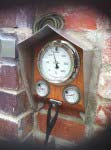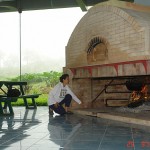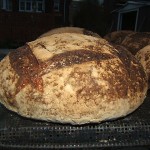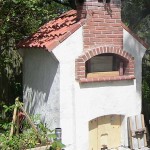Rectangular dome & round floor igloo dome types
Oven sizing, suitable heat resistant refractory material, plus which oven style performs better. The igloo round brick dome oven or the barrel rectangular floor type? Learn more about the dome, arch, vault shapes making and circular brickwork.
Rectangular floor dome versus round oven - circular dome sizes
On the graph below are two dome examples:
34" x 38" or 87 cm x 96.5 cm internal rectangle floor-space cooking area (barrel oven), and 34 inches or 87 cm round internal surface dome.
Oven of internal rectangular floor space 32" x 36" (82 cm x 92 cm) makes it a perfect home use oven for perfect pizzas, all roasts, cooking, baking and fruit drying.
Equally to that, round dome floor of the same internal surface area will be ~34" (86.4 cm) in diameter and add plus 2" (5 cm) for the same active surface for cooking when using spherical dome floor.

Same width rectangular and round domes
and fire positions diagram.
Circle area calculation:
A = π.r2
(π = 3.14 and r2 = half diameter2)
Visibly space-wise or room-wise there does not exist anything more to it than this.
Which dome is better to use, rectangle or round dome?
I receive many emails on this, people think one dome is better than the other. So ... if that one is superior ... is the other kind inferior ... or what?
Let's analyze which oven shape functions better; is there an outstanding one in the performance, and why?
You will cook the same high quality pizzas in the rectangular barrel oven dome, as you will bake lovely breads in the round dome. There should not be any dilemma nor confusion to take the right decision. In principle both dome types cook "exactly the same way." You will not get cold spots in the rectangular dome as well as you won't be disadvantaged with baking smaller breads in a round dome if you're not production baker (high quantity bakers prefer rectangular floor for the space reasons and heaps more favorable construction methods.) In the actual fact, all oven designs could be be labeled as first-class.

Same width rectangular and round domes
and fire positions diagram.
The data is going to get hotter and more detailed
In refractory industries; metallurgy, cooking or ceramics - huge, big and small furnaces, ovens or kilns (high or low heat levels), firebrick hot face chambers, use rectangular or square floor shapes with straight walls and arched ceilings - vault, these are easier to make and last very long. In my work with refractory for large metal companies or other small ones, it would be hard to imagine them using round igloo or the otherwise lovely half avocado shape chambers.
Technically not space wise, round floor chambers will do the job the same way when in a production but these domes are harder and costly to build properly. When built improperly igloos won't last. Other case would be if you plan to experiment with a short term wood oven, without a properly functioning flue (upwards hot air passage for the exhaust and also cold air inlet) and chimney, such as adobe mud oven, or if you plan to use it only rarely.
Barrel rectangle domes and round brick oven shape domes will heat up in the same time (more on this is explained in detail further below.) In small home ovens, or even in those 4m x 4m large bakery ovens with single firebox located on one side below the hearth height level, wood fire distributes its heat energy in rays by radiating covering the dome very evenly no matter where you put the fire in your chamber; sides, middle or at the back, heat energy penetrates evenly into dense firebricks, cladding, up, down, left, right, rear corners, door (called radiant energy) and only insulation stops it.
It is the same while cooking, heat radiates across the chamber evenly, heat rays from right side wall reach the left side wall having the same power across all corners, rays have far-reaching fingers ;o)
Fella can put many meals inside, there is no need to put meals just in the middle, those meals next to the wall will cook totally nicely in all wfo floor and dome types (different to an el. element or gas-burner heated conventional ovens with insufficient thermal mass and single heat source with an electric motor fan.) In wood fired oven restaurants owners keep the fire on a side on one spot, don't they?
Have you noticed this(?), who uses rectangular barrel and square dome oven types every day or extremely often? It is professionals or enthusiasts who do lots of cooking and mainly baking or roasting after a quick pizza start up. Their ovens may never cool down for they make daily needed bread or prepare food!!! And where is the evenly heated chamber with no cold spots atmosphere most required? In baking or roasting of course. Ask people who do some baking, there is entire community taking as lunch for work home made bread with olive oil or a roast slice in between, cakes, and even a cold pizza (:o)

Lamb leg and beef roasts with
1.5 Kg - 3.3 lbs rye bread loaf

Rye bread beef roast mustard sandwich
And their fellow colleagues just adore them and some even love them.
Easy maths;
for busy times when everyone lacks energy when it's extra valued; flour for 1 buck, add sugar for 20 cents, add somethings else (e.g. crushed pineapple, raisins, active yeast), mix it while adding water to soft consistency, pour/level on baking tray, bake it for 35-45 minutes at 180°C - 356°F (until golden), slice it, dust it with icing sugar, leave them laying on your desk. Let your top boss have a sniff too and there you go Mate ... the results get fabulous! Or just make muffins from self raising flour. No worries, they'll make their own coffee very fast. This effect requires to be consistent over a period of time!

60 (sixty) nice muffins
baked in brick pizza oven
Back to the subject - In this respect; heat never falls downwards (it can not fall), it radiates to every direction from every single pixel point on walls through meals, logically it is the physical law e.g. heat from the sun. Like the shop owner wanting to sell you not good blue candles, he knows it but they make him bigger profit ... He says "they burn longer" ... but We know this is not so because every candle burns only shorter and shorter.
If you wanted to speed up heating time in traditional wood fired oven, you would have to make the dome walls thinner and oven will heat up only 10-15 minutes quicker, but then it cools down faster, so you can use it mostly only for pizza while fire or red embers are alive. Well insulated or not, use of an oven with thin refractory thermal mass is limited.
Standard firebrick has high bulk density 1860kg/m3 hence very high mass thermal conductivity @ 750°C is 1.03 W/m.°K, alumina content 26% and meant to withstand in 1350°C - 2400°F continuous use, high duty very appropriate for wood burning ovens! Henceforth, higher alumina content makes firebricks double the price, you can use them but application for these suits to face very high heat in e.g. melting metals and not to increase heat storage capacity in wood ovens. Firebricks are made of natural best refractory "fire clay", like ceramic, they form wood oven chamber of many fragments. It is different in large blocks of cast-able cast ovens, here high alumina air-set cements must be used to bond the mixture particles and/or to avoid material pealing onto pizzas etc. (large blocks are also prone to cracking created by heat differences in material. In any type of dome use firebrick floor.)
(→ Top range dense kiln refractory has mass 2100kg/m3, higher amount alumina 38 - 40%, 1550°C, and conductivity is not much different @ 750°C is 1.07 - 1.13 W/m.°K - qualities not as much for wood ovens, these are used when the hot face is yellow - beyond red hot color 20 Orton Cone plus. To empty after treatments these furnaces must cool down slowly while being closed, especially just in the cooking temperature the 200°C range is critical when silica starts to shrink and so cracks in brittle material would develop in faster cooling, metallurgists could tell you about it when they loose expensive refractory shelves.) More physical properties numbers for all firebrick grades from 18% to 40% of alumina content in fire bricks. Plus soapstone thermal data - soapstone is also very commonly used.
Thicker/wider refractory oven walls are good for ecology, planet, firewood amount usage, oven efficiency, your pocket and cooking variety. E.g. you start to do pizzas in the same time as in thinner wall dome, but when your walls have bigger heat absorbing mass, then while you make pizzas in higher pizza making temperature the dome is continuing to absorb more heat energy as it has bigger heat absorbing capacity available. When you stop to make pizzas embers may be left to die out and your oven will be hot for longer time. This is very practical for many other activities after pizzas if you go for quality. After fire is left to die down, you will roast or bake cakes or breads in previous heat energy stored for 5 hours. Still after that use additional 10 hours for fruits or halved tomatoes drying time, for your toppings, all home made!
Evenings during the busy week days when you cook something quick for dinner, your oven with thick firing chamber walls will be cooling down much longer. Positive again, because if you are like me and fire the next day again your oven will still be warm the next evening and new firing time drops to 30 - 40 minutes while taking shower. Place great-marinated chicken pieces in and return to take them out in 15 minutes (i can not have pizza daily) and be with family, directly or indirectly more mass is better for cooking and other activities.
(For better dome heat absorbing mass concrete Cladding layer recipe page link is at the bottom.)
In both types of domes, heavy firebrick walls absorb heat from fire. For they high bulk density (1860kg/m3) all firebricks have very good heat conductivity so energy gets quickly spread everywhere in the medium equally creating evenly heated domes. (Like aluminium turns cold fast, so can heat travel within firebricks and make them very hot. Like sound travels fast in the water. Dense material conducts heat fast, but air spaces in heat insulation slow it down.) The floor is usually few degrees colder. Inside the oven, this heat energy is distributed by radiation and it radiates out from every point. Unless you leave pots right next to the entry the temperature is even everywhere, in the center or closer to walls. It is much more easier to cook in wood fired oven then in a conventional oven where the heat radiates from one side-single energy source e.g. gas burner or el. power heating element.
Structural and building differences in barrel and round brick ovens
After the first half in round igloo dome construction, gaps between bricks start to appear making it very hard to lay all firebricks accurately.

Gaps between firebricks in forming
round oven igloo style dome.
What it means? Inside the dome chamber, on the hot face, brick's edges have to be joined side to side (border to border.) Otherwise lots of mortar is required both in horizontal and vertical gaps between firebricks. It's fine at the bottom but the second half towards the top produces larger and larger gaps and too large in the last ~30% of dome forming. As soon as thin gaps start to appear bigger adjusting and cutting of bricks must start. Gaps between bricks on inside filled with mortar weaken the oven. These bricks get loose (wiggly) if there are gaps filled with mortar between them. After the initial firing, heat differences in material and expansion movements in the dome, mortar won't stay firmly bond to bricks as we knew it while mortaring. Refractory is not as masonry. Refractory mortar thicker than 1/4" (6mm) starts to shrinks and crack between bricks which later causes collapsing. Igloo dome does not have the line of thrust-rule diagram line like calculated self-standing catenary arch has as is used in e.g. arches in brick pottery kilns. Self standing catenary arch would have very high vault for cooking oven design (you can calculate low vault catenary arch but e.g. cladding needs to be loaded over to hold splitting the structure to sides.) Also in 'catenary curve arch' kiln bricks have to be cut precisely for it to last. From experience potters avoid mortar as much as possible (pottery is one of the oldest trades), loosen bricks attract gravity as center-top weight pushes towards sides causing collapse. You would have to rebuild it; or might be offered again some commercial pre-fabricated kit (hopefully not some lemon shell) because you already own a platform for a round oven purpose, as it happens. With the addition circular heated structures move not like roofs on buildings - best website on catenary arch stability notions and best to read if you are interested!
Have a look at all gaps between firebricks that show exactly how the ceiling would look like from inside - on outside bricks are more apart by the radius, these gaps can't be big too. It is not only the halving bricks. We have here triangles of all sizes, horizontally and vertically forming. These cannot be simply filled with mortar (at least not if you are building lasting quality oven project.) Here is heaps of cutting involved, I personally say a big job just to create only the hot face on inside properly. As you go in circles every following brick has to be adjusted by cutting to align and fit the one before, and so on, the off-cut will fit somewhere later (although usually for another dome.) "... Don't be scared be prepared." With barrel dome types you don't get these problems.
I wish one day I had the time to build round dome one more time, at least 183 cm + (72"+) restaurant diameter. When it comes to round ovens, large igloo domes are more practical than small regarding to surface space matters and big size definitely would have to have dome consisting of two precisely-cut brick skins for it to be strong and more efficient → (What ever it takes such project mainly be one's precision status, to proudly say to your friends "have a look inside!") I haven't encounter seeing photos that would clearly show making second half of the round igloo dome, ceiling from inside or outside, or before all bricks are covered with clay hiding crucial important details. All pictures turn to be focused somewhat away from the areas, diffused or are arranged as in a movie tricks, and people not getting the real things may be misled.
It would be great if someone had pictures of this kind and emailed some to me, both inside the igloo dome and outside for visitors to see the facts of how it goes. Thank you.
Why do they say a proper oven for pizza is round?

Thin base wood fired pizza ...
Maybe because when red-hot embers are pushed from the center to make space for pizzas this space or the actual pizzas are round. Exactly the same way it's done in rectangular domes too while getting more space. As well as you can bake breads in round dome, as well as delicious roasts can do in both dome types, perfect pizzas are being done in rectangular barrel domes and not only in round. Rather then the shape, the structural sizes are important; e.g. chamber height (vault), door width and height, wall thickness and insulation material. Wood fired pizza is famous, most restaurants selling this pizza have purchased and installed prefabricated round dome ovens, for business it is viable. Logically, this fact could influence opinions too, most people see ovens in restaurant where the pizza is made. Comparing with casting square objects, casting round oven is more practical and cost effective also.

Rectangular barrel style dome
32" x 36" or 82cm x 92cm
Round domes from the past were not made of firebricks as we know now days. When I was a child, in my grandparent's very old house, I used to play and sleep on top of one round oven. "Surely well insulated only pleasant heat did soak up through ... come on, what do you think of my grandparents?" (... Just joking) I witnessed rebuilding it, then they installed wood stove inside and built very good barrel wood fired oven outdoors, it was delightful time for me as a child operating this oven.

Perfect pizza from the barrel
rectangular floor dome.
Heating up a round brick ovens and barrel oven domes.
Traditionally, it's better to heat up ovens slowly using mini fire, so the heat soaked in walls cooks for you for a long time, slow heating process - more evenly heated walls (dense walls have equal temperature on inside and outside, insulation on outside protects this heat not to be wasted through the top - that would be the wrong way!) To heat up oven faster or to keep any type of wood burning dome hot for longer cooking times, it doesn't depend on it's shape (unless you were into scientific precision and be happy with totally minor differences.) It depends on if the oven has proper vault and door heights set, refractory part thickness and bulk density (one part of typical physical properties), heat insulation or if it is design having internal flue with draught/draft from chimney (with 'cold air inlet' when heating up) or more efficient front 'air vent and hot air passage' design. All types of domes can be efficient or not efficient.
Concrete cladding and efficiency in wood fired ovens.
Adding concrete cladding layer (ordinary) to any dome adds to the heat absorbing mass. Cladding is dense as well. It is not really an issue if this makes the dome to heat up longer, it does as it has more capacity to suck more energy in but only 20 - 30 more minutes in moderate complete heating of a home oven. For pizza, barrel dome or igloo oven with cladding layer can be heated up in 1 hour (home oven → 82cm x 92cm or 87cm x 102cm which is 32"x36 to 34"x40"), then leave small flame going on to continue making pizzas or finish properly heating up for above mentioned time. Cladding is needed and will not prolong heating time into extremes so no disadvantage (one could be if the dome was thin.*) 5cm (2") of extra cladding layer gives all cooking options making life more amusing (while making pizzas firebricks and cladding thermal conductivity continues to absorb more energy from fire, ten wide walls efficiently release the collected heat very slowly into the chamber.

Continuous fire in rectangular floor barrel dome.
After fire is left to die down, you will roast or bake cakes or breads in previous heat energy stored for 5 hours. Still after that you can use additional 10 hours of fruits or halved tomatoes drying time, for your toppings, all home made!) Many ovens drop temperature fast not holding heat, or floor gets too cold for pizzas (that is common problem.) It's good to have bigger then small mass, it's practical in many aspects, and it is much better. You will not use much more firewood at all because of cladding, imagine wood campfire going on and next to it kitchen type of ordinary BTU gas burner. How many times bigger is the produced energy from wood fire? Many times, and it's only one aspect why wood fired ovens are very practical and pleasing (Mate ... I slipped off from the main topic again.)
Applying heat back up insulation.
For efficiency insulate* your dome really well on the outside, whichever type of dome you decide to make, it is better, smarter and logical too.
I hope you find the spherical versus rectangular oven floor information useful.
* If you had oven entirely only for making few pizzas while red hot embers are still radiating heat across the dome when the floor is still very hot, and after that you wouldn't need to hold the heat in for longer time, e.g. use the oven for roasting or baking, then you can have the dome thinner without cladding or minus the thermal insulation.
by Rado Hand
Related: learn more about:
- Which dome is better - a round igloo shape or a rectangle?
- Refractory mortar - kinds and mixing formula's for making your own
- Dome cladding layer - for efficiency and durability
- Thermal insulation - types and mixing formula's




